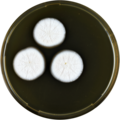| Aspergillus polyporicola | |
|---|---|
| Scientific classification | |
| Kingdom: | Fungi |
| Division: | Ascomycota |
| Class: | Eurotiomycetes |
| Order: | Eurotiales |
| Family: | Aspergillaceae |
| Genus: | Aspergillus |
| Species: | A. polyporicola |
| Binomial name | |
| Aspergillus polyporicola Hubka, A. Nováková, M. Kolařík, S.W. Peterson (2015) [1] | |
Aspergillus polyporicola is a species of fungus in the genus Aspergillus . It is from the Flavipedes section. [2] [1] The species was first described in 2015. [1]

